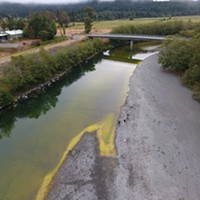Thursday, July 19, 2018
Health Officials Issue Blue-Green Algae Warning
Posted By Kimberly Wear @kimberly_wear on Thu, Jul 19, 2018 at 10:46 AM
Local health officials have issued a warning to watch out for cyanobacteria — more commonly referred to as blue-green algae — in local waterways.
Some species of the bacteria can be toxic to humans and animals, with children and dogs the most vulnerable to its harmful effects.
The release notes that it is difficult to test and monitor all of the lakes and rivers in the region but “cyanobacteria has been previously confirmed in some water bodies within Humboldt, Mendocino and Lake counties including the South Fork Eel River, Van Duzen River, Trinity River, Clear Lake and Lake Pillsbury.”
While many of the bacterial blooms — which appear as mats or foam of dark green, blue-green, black, orange or brown scum floating on the water’s surface — officials caution that “it is important to stay safe and avoid contact.”
Read the Department of Health and Human Services release below:
Some species of the bacteria can be toxic to humans and animals, with children and dogs the most vulnerable to its harmful effects.
The release notes that it is difficult to test and monitor all of the lakes and rivers in the region but “cyanobacteria has been previously confirmed in some water bodies within Humboldt, Mendocino and Lake counties including the South Fork Eel River, Van Duzen River, Trinity River, Clear Lake and Lake Pillsbury.”
While many of the bacterial blooms — which appear as mats or foam of dark green, blue-green, black, orange or brown scum floating on the water’s surface — officials caution that “it is important to stay safe and avoid contact.”
Read the Department of Health and Human Services release below:
Local Public and Environmental Health officials are warning recreational users of all bodies of fresh water to avoid contact with cyanobacteria (also known as blue-green algae).
The North Coast Regional Water Quality Control Board in cooperation with the Humboldt County Department of Health & Human Services, Mendocino County Environmental Health and Lake County Public Health Division issued a warning to avoid contact with cyanobacteria and algal blooms. Although commonly referred to as blue-green algae, following the lead of the state, jurisdictions are using the term cyanobacteria as it is not algae, but bacteria.
Typically, cyanobacteria warnings come out between late July and early August, coinciding with low flows and sustained high temperatures in the inland areas which may contribute to cyanobacteria growth in the river.
Human activities have an effect on nutrient and water flows in rivers, streams and lakes. Nutrients found in fertilizers, animal waste and human waste can stimulate blooms. Excessive water diversions can also increase water temperatures and reduce flows. People can take the following measures to prevent algal blooms in our waters:
Be conservative with the use of water, fertilizers and pesticides on your lawn, garden or agricultural operation.
Avoid nutrient runoff by recycling any “spent” soil by tilling it back into gardens, or protecting it from rainfall.
Create shade and filter out nutrients by planting or maintaining native plants around river banks.
Inspect and pump out septic systems every three to four years.
Prevent surface water runoff from agricultural and livestock areas.
Prevent erosion around construction and logging operations.
Cyanobacteria can be present in any fresh water body. It looks like dark green, blue-green, black, orange or brown scum, foam or mats on the riverbed or floating on the water. Warm water and abundant nutrients can cause cyanobacteria to grow more rapidly than usual causing “blooms.” These blooms are termed “harmful algal blooms.” Most cyanobacteria does not affect animals or people, however, a small number of cyanobacteria species are capable of producing toxins that can be harmful to animals and humans. Dogs and children are most likely to be affected because of their smaller body size and tendency to stay in the water for longer periods of time.
The presence of cyanobacteria has been previously confirmed in some water bodies within Humboldt, Mendocino and Lake counties including the South Fork Eel River, Van Duzen River, Trinity River, Clear Lake and Lake Pillsbury. It is difficult to test and monitor the many lakes and miles of our local rivers. Most blooms in California contain harmless green algae, but it is important to stay safe and avoid contact.
Officials recommend the following guidelines for recreational users of freshwater areas:
Keep children, pets and livestock from swimming in or drinking water containing algal scums or mats.
Adults should also avoid wading and swimming in water containing algal blooms. Try not to swallow or inhale water spray in an algal bloom area.
If no algal scums or mats are visible, you should still carefully watch young children and warn them not to swallow any water.
Fish should be consumed only after removing the guts and liver and rinsing fillets in tap water.
Never drink, cook with or wash dishes with water from rivers, streams or lakes.
Get medical attention immediately if you think that you, your pet, or livestock might have been poisoned by cyanobacteria toxins. Be sure to tell the doctor or veterinarian about possible contact with cyanobacteria or algal blooms.
Join or support one of the many watershed and river organizations.
To learn more about cyanobacteria and harmful algal blooms, visit the state of California’s website here.
To learn more about cyanobacteria and algae on the South Fork Eel River here.
Reports blooms at [email protected] or by calling 844-729-6466 (toll free).
Blooms can also be reported via the “bloomWatch” app which is available for free download on iTunes or Google play.
For information on conditions occurring within Humboldt County, contact the Division of Environmental Health at 707-445-6215 or 800-963-9241. Photos of suspected blooms can also be emailed to [email protected].
Speaking of...
Readers also liked…
more from the author
-
Dust to Dust
The green burial movement looks to set down roots in Humboldt County
- Apr 11, 2024
-
Our Last Best Chance
- Apr 11, 2024
-
Judge Rules Arcata Can't Put Earth Flag on Top
- Apr 5, 2024
- More »



































